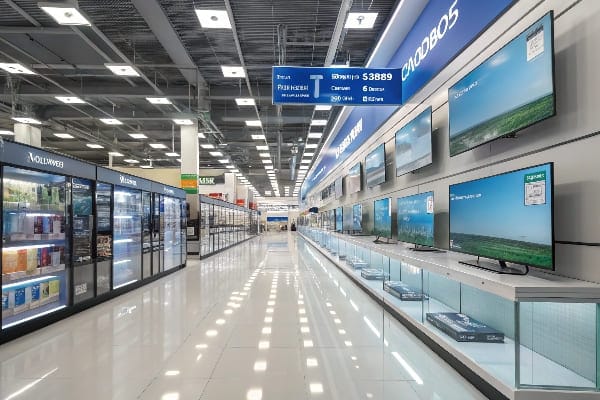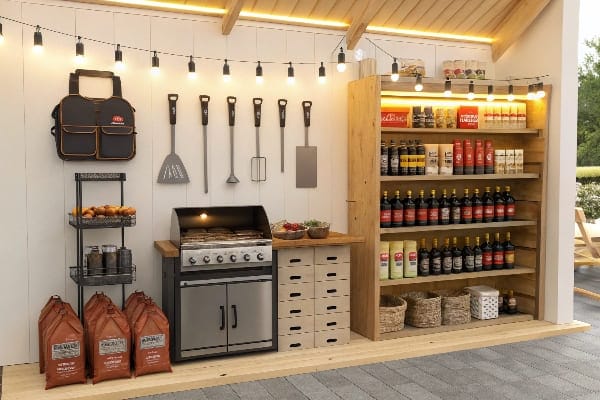Customers miss hidden add-ons every day. Sales dip and stock gathers dust. I felt the tension until smart displays turned browsers into bundle buyers.
Cross merchandising puts related products together on clear, themed displays so shoppers see, connect, and buy complementary items in one visit.

Stay with me while I break down each tactic and show how you can repeat my wins without large budgets.
What is cross merchandising strategy?
Many stores count on chance for add-on sales. Shoppers rarely notice loose extras. This gap hurts margin until cross merchandising steps in.
A cross merchandising strategy is a planned effort to place complementary products together in one display or area to spark impulse sales.

Why grouping works
Shoppers move fast. Their eyes land on bold shapes first. When one stand gathers everything for a full task, the brain labels the set as a quick answer. No extra search. This simple clarity cuts choice stress and grows basket size1. It feels helpful, not pushy. The tactic also plays well with modern high-margin small items, which often get lost on long shelves.
My factory view
I build cardboard units that join crossbows with wax kits and safety glasses. When one U.S. chain tried the idea, unit sales of wax rose 47 % in four weeks. The buyer phoned to thank us because the display fixed two pain points: poor add-on visibility2 and clutter. The knock-down design lowered freight, and the high front lip kept arrows from sliding out during shopper grabs. My team prints quick guides on the side panel. Hunters scan the QR code, watch a 15-second loop, and feel ready to shoot.
Common pairings
| Core Item | Add-On | Benefit to shopper |
|---|---|---|
| Crossbow | Wax kit | Longer string life |
| Coffee maker | Travel mug | Fresh drink on commute |
| Laptop | Sleeve | Safe carry |
Smart grouping lifts units, shortens dwell time, and strengthens trust because shoppers see every need solved in one place.
What is merchandising strategy in retail?
Empty space swallows profit. Random product piles confuse shoppers. I once watched people circle an aisle twice, then leave. A full merchandising plan ends the maze.
A retail merchandising strategy is the full plan for how, when, and where products appear in-store to meet shopper needs and hit profit goals.

Scope of the plan
A sound plan covers layout flow, category roles, shelf standards, pricing cues, and change cycles. It links brand promise to physical form. I begin by mapping shopper missions3—grab-and-go, stock-up, explore—and I place fixtures to match those paths. The goal is less search, more delight.
My simple five-step map
- Define target missions by hour and day.
- Assign space to missions, not departments.
- Choose fixtures that guide the eye line4. Cardboard for feature spots, metal for heavy stock.
- Write clear rules for fill levels, tags, and lighting.
- Review movement data5 weekly and tweak fast.
Table: Mission and Fixture Fit
| Shopper Mission | Best Fixture | Key Design Cue |
|---|---|---|
| Grab-and-go snacks | End cap | Contrast color header |
| Weekend DIY project | Mid-aisle island | Step-by-step graphic |
| Gift hunt | Front-of-store tower | Ribbon motif |
When each mission finds a home, dwell time grows in zones that matter, not in dead ends that frustrate.
What is the best way to display merchandise?
Great products can sink behind flimsy units. I once lost a buyer because our stand bent after a week. Strength and sight lines save both trust and margin.
The best way is to match display type to shopper mission: clear sight lines, eye-level focus, sturdy materials, and tidy stock that invites touch.

Key design rules
Eye line is buy line6
Keep the hero item between shoulder and hip height. If height varies, angle shelves up slightly so the face still meets the gaze.
Tell, do not ask
Bold headers state the benefit in five words or fewer. Busy shoppers skip long pitches.
Touch wins7
Open fronts or test pieces pull hands forward. When fingers engage, the chance of a sale jumps.
Material matters8
Cardboard makes fast setup and color punch. But it must bear load. In my factory I use a B-flute core for boxes under three kilos and dual wall for heavier gear. Every proto gets a drop test. I share the video with the client to remove doubt.
Table: Display Choice Guide
| Goal | Display Type | Best Location |
|---|---|---|
| Launch new flavor | Shipper floor stand | Entry power alley |
| Drive bulk buy | Pallet skirt | Warehouse aisle |
| Upsell premium line | Tiered shelf insert | Inline eye level |
True best practice is fit. Pick a unit that matches product weight, story, and shopper pace. Then sales climb without extra staff.
What are the strategic decisions of merchandising in retail?
When I planned my first full store, I felt lost. So many knobs: how wide, how deep, how often. I needed a simple frame.
Key decisions cover assortment width, depth, timing, pricing, presentation, and replenishment policies that fit brand goals and shopper behavior.

Six decision levers
- Width – How many categories to stock.
- Depth – How many SKUs per category.
- Timing – When to launch or end offers.
- Pricing – Everyday, promo, and markdown mix.
- Presentation – Fixtures and graphics.
- Replenishment – Speed and trigger points.
How I pull the levers
For U.S. hunting season I widen the archery range9 in August, deepen arrow variety by 20 %, and pull back once deer season ends. Signs show “Season Ready” to cue urgency. Prices stay everyday low; instead I bundle wax and lube free to hold margin.
Table: Lever Impact
| Lever | Fast Win | Long Win |
|---|---|---|
| Width | Add trending SKU10 | Grow new category |
| Depth | Offer size choice | Build loyalty |
| Timing | Flash display | Pre-plan promo calendar11 |
Link the levers to one headline goal at a time. That focus keeps the plan simple for staff and sharp for shoppers.
How can stores communicate effectively with customers through merchandising and displays?
I have no sales staff in many displays. The unit has to speak for me. Words alone fail. Form, color, and motion carry the story.
Stores speak through color, layout, props, wording, and motion; aligned cues tell shoppers what to feel, find, and buy within seconds.

Five communication tools
Color coding12
Colors set mood fast. Warm tones suggest value. Cool tones hint quality. I pick brand core colors and one high-contrast accent to guide the eye.
Story layout
A mini path on the stand moves left to right: need, solution, extra benefit. Arrows or subtle patterns push the gaze.
Props and scale13
A life-size deer cut-out next to a crossbow stand lets hunters picture success.
Simple copy14
“Ready. Aim. Relax.” Three words beat long bullets.
Motion
A slow LED pulse behind the hero box draws glances without noise.
Table: Tool and Shopper Signal
| Tool | Main Signal | Example |
|---|---|---|
| Color | Price or quality cue | Gold band signals premium |
| Layout | Flow direction | Arrow graphic |
| Prop | Context | Mini tent with stove |
When every cue points to one feeling, buyers decide fast and leave happy.
What display techniques are used in visual merchandising?
Displays keep changing. Some tricks last. Others fade. I test each one in small runs before rolling wide.
Visual merchandising uses focal points, storytelling vignettes, color blocking, rule of three groupings, lighting layers, and interactive zones.

Proven techniques
Focal point15
Place the priciest or most newsworthy item dead center. Light it brighter than surroundings. The eye lands there first.
Story vignette
Build a mini scene. For crossbows I add faux leaves and a small target. Shoppers imagine the hunt.
Color block
Group items by one strong hue. The mass effect stops traffic even in busy aisles.
Rule of three
Arrange products in odd numbers. Three feels complete yet dynamic. I stack three box heights stair-style to guide the gaze upward.
Layered lighting16
Mix spot LEDs on top with soft strip lights below. Depth grows, shadows fall away, and colors pop.
Interactive zones17
Add a QR video or a pull tab sample. Interaction turns a passerby into a participant.
Table: Technique and Goal
| Technique | Goal | Quick Check |
|---|---|---|
| Focal point | Draw eye | Is hero lit 2× brighter? |
| Story vignette | Emotional link | Does scene match buyer dream? |
| Rule of three | Visual balance | Odd count kept? |
Mix two or three techniques at once, test lift, then refine. The best mix stays fresh without costing a fortune.
Conclusion
Cross merchandising and clear display rules turn aisles into silent salespeople, lifting impulse buys and trust without heavy spend.
Understanding the factors that influence basket size can help retailers optimize their strategies for increased sales. ↩
Improving add-on visibility can significantly enhance sales and customer satisfaction, making it a crucial area for retailers to focus on. ↩
Understanding shopper missions can enhance your retail strategy, ensuring a better shopping experience and increased sales. ↩
Learn how effective fixture placement can lead to better customer engagement and optimized store layouts. ↩
Exploring movement data can help you make informed decisions to improve store layout and customer satisfaction. ↩
Understanding this principle can significantly enhance product visibility and sales effectiveness in retail environments. ↩
Exploring this concept can reveal how engaging customers physically with products boosts their likelihood to purchase. ↩
Learning about the significance of material can help in creating effective and durable retail displays that attract customers. ↩
Explore this resource to learn effective strategies for expanding your archery range and attracting more customers. ↩
Find insights on identifying trending SKUs to enhance your product offerings and boost sales. ↩
Discover tips on creating a promotional calendar that maximizes sales and engages customers effectively. ↩
Explore how color coding can enhance communication and influence buyer decisions effectively. ↩
Learn how props can create relatable contexts that enhance customer engagement and visualization. ↩
Discover the power of concise messaging and its role in capturing attention and driving sales. ↩
Explore this link to discover how to effectively draw attention to key items in your retail space, enhancing customer engagement. ↩
Learn how layered lighting can transform your retail environment, making products more appealing and inviting to customers. ↩
Discover the advantages of interactive zones in retail, which can significantly boost customer participation and sales. ↩

